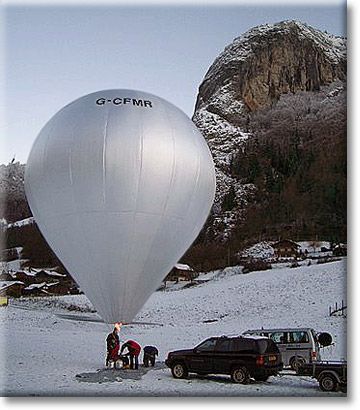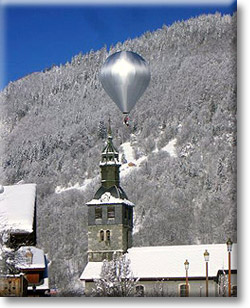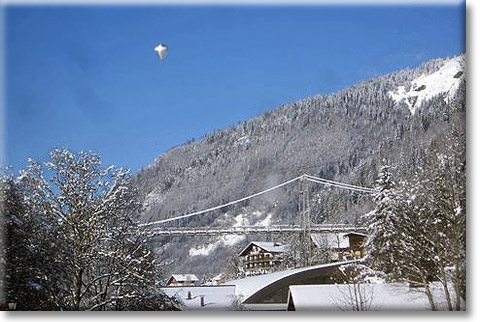Congratulations to Mark Shemilt from the worldwide Ultramagic team. Mark Shemilt’s World Record is now official!
Meanwhile Michael Boelling and his father in Brigachtal, Germany were making me a miniature double burner, using their extensive knowledge of building model balloons. We also developed a paraffin burner based on the sheen weedkille burner, which worked well when preheated, but became a flamethrower when it cooled, so I decided to stick with good old propane.
Michael suggested I look into a new insulated balloon fabric that had been developed by Alex Borman of Aeroix and Berlin University during their HEIDAS project, or steam powered balloon. This fabric termed ‘Aerofabrix’ is essentially two layers of 45gsm silver woven ripstop separated by flock dots that serve to keep the 2 fabrics apart by a fractional distance. I gathered that much research had gone into the optimal separation distance between the twin skins (without touching) and in its reflective properties. The other attraction of this fabric was that it is relatively robust; the Festo 105 has already racked up 150hrs. Ultramagic have the sole rights to this fabric and after a trip to Igualada and a chance to fly their Aerofabrix duo I commissioned my small envelope. However all my queries into the fabric’s fuel consumption in such a small envelope were met with shrugged shoulders, there were simply too many variables. Along with Paul Dickinson and Josep Lladó of Ultramagic we designed a sphere on cone design, with a simple Velcro rip (parachutes tend to leak on this size) and the smallest mouth we could get away with to retain heat. The balloon had stub load tapes and no horizontal tapes to save weight.
However there are two major disadvantages of Aerofabrix. Firstly its weight at 90gsm is the same as Hyperlast and I was gambling that if I used this fabric that its miserly fuel consumption would be worth the extra weight. Secondly the fabric is eye wateringly expensive, ostensibly in order to recover the developmental costs.
The Boelling model burner was pure genius. Using miniature valves and fittings, and a separate pilot light feed fed from a 1 litre Ali bottle. My fuel tanks were small composite bottles which are available all over Europe in different guises (check out butagaz’ viseo bottle). I simply removed the outer plastic casing and then shaved all extraneous fibreglass and resealed with resin, until I had a 20 litre tank weighing 2kg empty. Don’t try this at home folks! We pressure tested them to 20 bar but undoubtedly had compromised their integrity. My harness was a lightweight paragliding number and the plan was to drop tanks as I used them, further increasing performance.
Probably the hardest part of any serious record attempt is the necessity of the pilot having to lose weight to become what Hempelman Adams calls an anorexic whippet! My weight normally is 80kg and I wanted to get down to 65kg (still a long way off Pauline Baker’s petite 45kg). I managed 67kg by living off cups of tea, but with all the warm weather gear, I added another 4kg.
|
I should add at this point that for a record attempt, there is also a lot of paperwork and permissions that have to be obtained (especially from the NAC of the country in which the record is to be attempted). Any homebuilt/historical or record balloon under new EASA rules is eligible to be listed as Annex 2, which as long as it UK registered and insured, makes it exempt from a permit to fly or a certificate of airworthiness, which is one hell of a concession and I would have thought a boost for homebuilding. The last annoyingly intangible facet of balloon record breaking is of course the weather and temperature. I elected to trial the balloon in the French Alps, near Morzine ,where I have spent the last 4 years renovating a barn and an area I have ballooned many times and although at 1000m, occasionally very cold. It became apparent on its maiden flight from St Jean D’Aulps in a balmy 5 degrees that the balloon fuel consumption was incredible and very competitive. |
|
Sue Carden, a BBAC observer came out the next week, with my trusty crew, we met at 6am on Sunday 7th December in the field below the house in a disappointing minus 5 degrees Celsius. My first set back was that my thermocouple wire opened the vent when we stood the balloon up, so I removed it thereby denying myself the ability to monitor envelope temperature at take off. In light of the decidedly uncompetitive ambient temperature I elected to carry less fuel than planned.
As I launched, I was glad to see the first glimmers of sunlight, and remembered Don Cameron’s advice that a cold but sunny day was optimal duration record breaking conditions. Apparently any flying in the dark will gobble up fuel. My fuel tank drops passed without event and despite adiabatic winds pulling me up forested slopes around Morzine, I felt unconcerned as I knew this balloon had the legs for a long flight. Possibly the scariest bit of the flight was when my pilot lights went out and I discovered my 1 litre vapour tank was empty after 5 hours airborne (this was bizarre as we had previously run the pilot lights for a good 10 hours previously on this tank), perhaps I had them turned up excessively. Because I was over trees my trusty 3 euro gas match came into its own, acting as a pilot light to each burn, which by now was about once a minute. Never in my life have I held onto something so tightly! As I passed the ax2 existing record mark, I was aware my last tank was getting light and as I reached the ax3 record at 7hrs 30mins (sadly I needed to exceed this by 1% or 7 mins to beat it) it became clear that the burner note was changing and I landed straight away in the town centre of Morzine.
Clearly this envelope fabric is something special and I feel really to do it Justice I should take it somewhere colder and carry more fuel. I now want to try a distance record in this balloon which stands at about 85 miles. The Alps are not a place for distance records in a hopper, the one time I experienced some wind shear was hair raising and deflected the flame burning some mouth panels. You feel very exposed in a harness under a balloon, so small that you can see the stitching at the top of the balloon whilst you get sucked up 3000m summits."
Mark Shemilt.
|
FAI has ratified the following Class A (Free balloons) World record: Claim number: 15234 FAI congratulates the Pilot on this splendid achievement. |
|
Congratulations Mark on a wonderful achievement and thank you for putting your trust in Ultramagic.
Here is part of an article written by Mark Shemilt about his balloon and the record breaking flight just after the flight in December 2008:
"I love the technical and developmental side of small balloons and for a long time have felt that just about all balloon equipment is too heavy. A duo airchair when fuelled still takes 4 people to lift the bottom end! Having set some British records with stock balloon equipment, I wanted to have a go for a world record and felt ax2 was a class that appealed.
It was obvious from the start that twin skin for the envelope was the way to go, despite an increase in weight. Both Pierrick Duvoisin and Steve Griffin had favoured Mylar, and yet Rich Jaworki’s woven fabric ax4 twin skin had returned awesome duration. I didn’t fancy flying under a foil balloon held together with tape with its low tear resistance, so looked into lightweight woven fabrics (weighing as little as 23gsm) and even the possibility of a solar balloon like the Michaelis balloon of Julian Nott (translucent outer envelope and opaque inner). However small balloons have very little core temperature and I felt that the advantages of a solar balloon would be lost on a 400m3 or 14000cu ft.
|
|
|
Mark over Morzine in G-CFMR – (jpeg M. Shemilt) |


